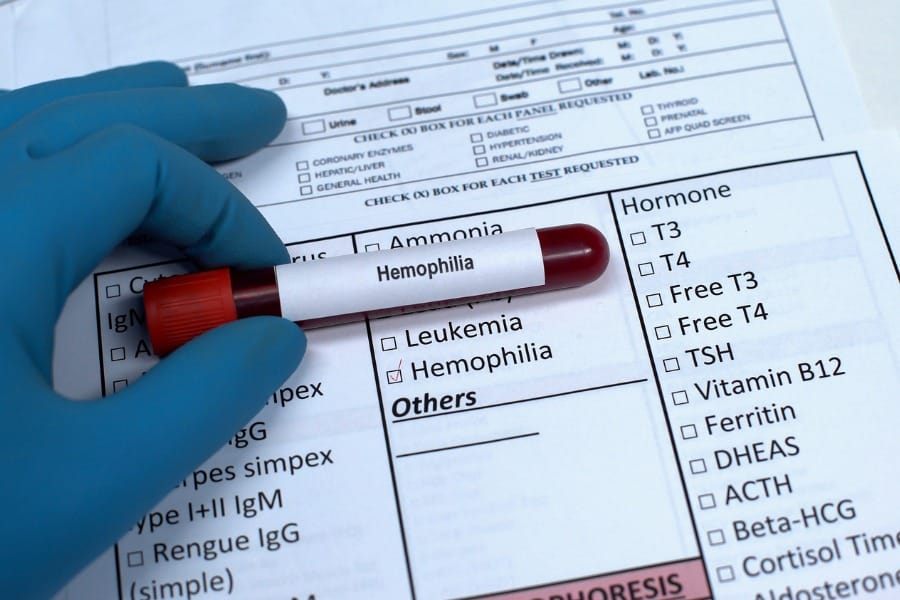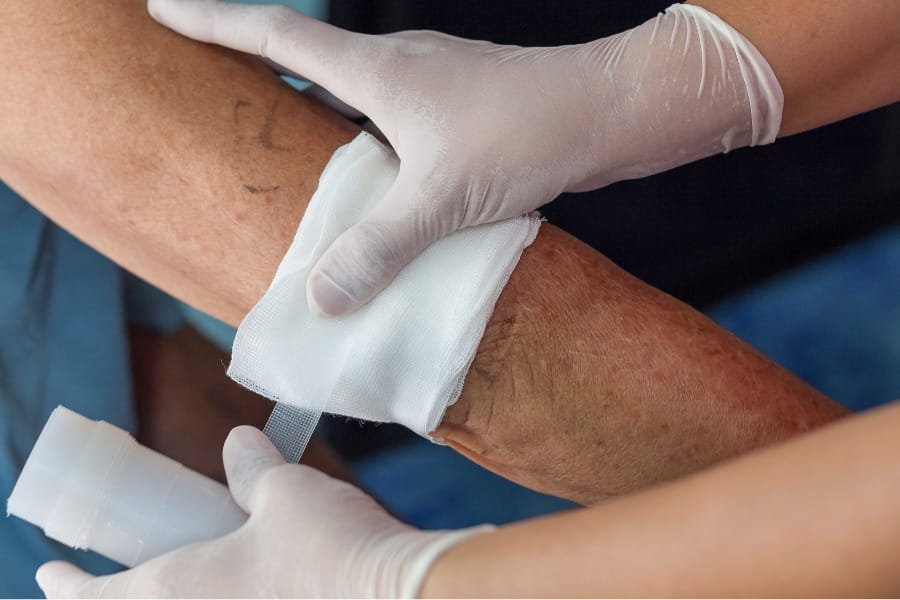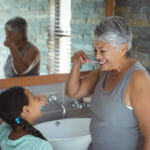Hemophilia is a blood clotting disorder that occurs when there is insufficient blood proteins causes abnormal clotting of the blood. The severity of hemophilia can vary greatly between individuals, and for some, it can be life-threatening.
While it is often genetically inherited, it can be caused by a spontaneous genetic mutation. The US Centers for Disease Control and Prevention (CDC) claim that hemophilia is found in 1 out of 500 births. After an injury occurs, people with hemophilia bleed longer than those with normal blood clotting. The largest health concern for hemophiliacs are deep bleeding inside the body, as internal bleeding can cause problems in tissues and organs.
What is Hemophilia?
IN THIS ARTICLE
Hemophilia is a rare bleeding disorder that affects the blood’s ability to clot. It is caused by a deficiency or absence of clotting factors in the blood, which are proteins that help the blood to clot. This can result in prolonged bleeding after an injury or spontaneous bleeding into joints, muscles, or organs.
Genetics of Hemophilia
Hemophilia is an inherited disorder that is passed down from parents to their children through their genes. The genes responsible for hemophilia are located on the X chromosome, one of the two sex chromosomes. Since males have only one X chromosome, they are more likely to develop hemophilia than females. Females can also be affected by hemophilia, but it is rare. Females can be carriers of the condition and pass it on to their children.
Can People Develop Hemophilia?
Hemophilia is an inherited disorder and cannot be developed later in life. It is caused by a mutation in one of the genes that are responsible for producing clotting factors in the blood.
Causes of Hemophilia
When you experience a cut, normal blood cells are pushed together to form a clot that prevents continuous bleeding. Blood-clotting particles control this process.
When there are inactive or deficient blood proteins, issues with coagulation occur, making it difficult for the blood to stick together. Often, hemophilia is hereditary. However, 30 percent of individuals with the disorder have no family history of the disease. Individuals with acquired hemophilia develop the disorder spontaneously when a gene associated with hemophilia mutates, which happens when an individual’s immune system targets clotting factors throughout the blood.
Risk Factors

The most significant risk factor for hemophilia is the genetic component; if you have family members who carry the disorder, you are at an increased risk. It is rare, but an individual can also acquire the condition if they have multiple sclerosis, cancer, autoimmune conditions, or are pregnant.
Types of Hemophilia
There are three types of hemophilia: hemophilia A, hemophilia B, and hemophilia C. Hemophilia A is the most common type and is caused by a deficiency of clotting factor VIII.
Hemophilia B is caused by a deficiency of clotting factor IX. Hemophilia C is caused by a deficiency of clotting factor XI and is less common than hemophilia A and B.
Symptoms of Hemophilia
Symptoms vary from person to person. The severity of the illness depends on the level of clotting factors in the blood.
The most common symptom of hemophilia is prolonged bleeding after an injury or surgery.
A person with a mildly reduced clotting factor may only bleed after trauma or surgery.
On the other hand, a person with severely reduced clotting factor may experience spontaneous bleeding.
Some examples of spontaneous bleeding include random nosebleeds, blood in the urine or stool, many large or deep bruises, and unexplained irritability in infants.
People with severe hemophilia may experience spontaneous joint bleeds, muscles, or organs, which can cause pain and swelling.
Other symptoms of hemophilia may include easy bruising, pain or swelling in the joints, abnormal bleeding after vaccinations, excessive bleeding from cuts, nosebleeds, and blood in the urine or stool.
Overall, hemophilia is a rare bleeding disorder caused by a deficiency or absence of clotting factors in the blood.
Diagnosis and Treatment for Hemophilia

Diagnostic Procedures
Diagnosis of hemophilia involves a combination of medical history, physical examination, and laboratory tests.
Doctors may ask about any family history of bleeding disorders, previous bleeding episodes, and any medication or supplements that the patient is taking.
For expectant mothers with a family history of the disorder, doctors can test for and determine whether a fetus is at risk of developing hemophilia.
A blood test can determine a clotting factor deficiency in adults and children.
Symptoms may appear at different ages, depending on the severity of the deficiency; some symptoms may not be apparent until adulthood.
While many people don’t learn they have the disorder until they receive a serious injury or have a surgical procedure, extreme cases are typically diagnosed before the age of one.
Blood tests are used to determine the clotting factor levels and any antibodies that may be present.
Clotting factor VIII and clotting factor IX levels are measured to determine the type and severity of hemophilia. Genetic testing may also be done to confirm the diagnosis and determine the specific genetic mutation that causes the condition.
What are clotting factor levels?
Clotting factors aid in the management of bleeding. According to the quantity of clotting factors in your blood, medical professionals classify hemophilia as mild, moderate, or severe:
- People who have 5% to 30% of the normal amount of clotting factors in their blood have mild hemophilia.
- People with 1% to 5% of the normal level of clotting factors have moderate hemophilia.
- People with less than 1% of the normal clotting factors have severe hemophilia.
Treatment Options for Hemophilia
There are different forms of hemophilia that correspond with deficiencies in different blood-clotting proteins. The most common treatment for hemophilia is to replace the specific clotting factor that an individual needs. Because of this, the treatment plan differs based on the type of hemophilia a person is diagnosed with.
- Hemophilia A treatments include concentrated FVIII product
- Hemophilia B treatments include concentrated FIX product
These factors are administered intravenously through a vein in the arm or a port in the chest. For those with severe hemophilia A, especially children, prophylaxis is recommended as a continuous treatment to maintain enough blood clotting factors in the body to prevent bleeds.
The management of hemophilia involves replacement therapy, prophylaxis, and treatment of inhibitors. Replacement therapy involves infusing the missing clotting factor VIII or factor IX into the patient’s bloodstream. This can be done as needed for bleeding episodes or as a preventative measure for those with severe hemophilia.
Prophylaxis involves regular infusions of clotting factor to prevent bleeding episodes. This is recommended for those with severe hemophilia and has been shown to reduce the incidence of joint damage and other complications.
Inhibitors are antibodies that develop in response to replacement therapy and can reduce its effectiveness. Treatment of inhibitors may involve immune tolerance induction, which gradually increases the patient’s tolerance to replacement therapy.
Regular medical care is important for those with hemophilia to monitor clotting factor levels, manage bleeding episodes, and prevent complications. Patients should also avoid activities that may increase the risk of bleeding, such as contact sports and certain medications.
There are other treatments available for specific purposes; for instance, some are meant to be taken before surgery. Below is a list of alternative treatments for hemophilia.
Desmopressin. Desmopressin is a hormone which can stimulate the body to release a larger amount of clotting factor. It can be administered into a vein or through the nasal cavity.
Clot-preserving medications. Clot-preserving medications assist the body by preventing blood clots from breaking apart.
Physical therapy. Those with severe hemophilia may experience bleeding into the joints and muscles, which can damage the body over time. Physical therapy can help relieve some symptoms of joint damage, though severe damage to joints may require surgery.
Fibrin sealants. This is a medication that is administered directly on the location of the wound to encourage better healing and clotting. These sealants are used often, especially in dental therapy.
First aid for small cuts. Applying pressure and using a bandage can stop the bleeding much of the time. An ice pack can be used for smaller areas of bleeding that occur beneath the skin. Icicle pops can be used as an alternative for bleeding that occurs in the mouth.
Lifestyle. Regular exercise such as swimming or walking can prevent excessive bleeding. Certain medications, like ibuprofen and aspirin, can increase the amount of bleeding that occurs.
Living with Hemophilia

Living with hemophilia can be challenging, but with proper care and management, people with hemophilia can live full and active lives.
Daily Life Considerations
People with hemophilia need to take certain precautions to minimize the risk of bleeding and injury. It is important to avoid activities that may result in injury or bleeding, such as contact sports or heavy lifting.
However, regular exercise is important for maintaining muscle and joint health, and low-impact activities such as swimming or cycling are generally safe.
Maintaining a healthy weight is also important for people with hemophilia, as excess weight can put additional strain on joints and increase the risk of bleeding.
Potential Complications
Complications can arise when bleeding occurs, particularly if the bleeding is internal. Internal bleeding can cause swelling and pressure on surrounding tissues, which can lead to pain and potential damage to organs or joints.
In some cases, people with hemophilia may develop inhibitors, which are antibodies that can prevent clotting factor treatments from working effectively.
Physical therapy may be helpful in managing joint pain or damage, and vaccinations can help prevent infections that could lead to bleeding.
In the event of a bleed, it is important to apply pressure and seek medical attention if necessary. Nosebleeds, headaches, seizures, and deep internal bleeding are all potential complications of hemophilia and should be monitored closely.
Overall, with proper care and management, people with hemophilia can lead healthy and active lives. By taking precautions to minimize the risk of bleeding and injury, and seeking medical attention when necessary, people with hemophilia can manage their condition and enjoy a full range of activities.
NurseRegistry can help individuals with hemophilia and parents of children with hemophilia.
We have dedicated private nurses who can help with administration of IV therapies, post-surgical care, and pediatric care. Our nurses are highly qualified, skilled, and can provide a full range of skilled services. From care for severe conditions like hemophilia or pancreatic cancer to simple wellness checks, NurseRegistry can help.
If you want to learn more about how a private duty nurse can help, click below to speak with our Intake Specialist about your specific care needs.
Frequently Asked Questions about Hemophilia
What are the different types of hemophilia?
There are two main types of hemophilia: Hemophilia A and Hemophilia B. Hemophilia A is caused by a deficiency of clotting factor VIII, while Hemophilia B is caused by a deficiency of clotting factor IX.
How is hemophilia inherited?
Hemophilia is an inherited condition that is passed down from parents to their children through the genes. The gene that causes hemophilia is located on the X chromosome, which means that the condition mainly affects males. Females can also be carriers of the gene and pass it on to their children.
What are the main symptoms of hemophilia?
The main symptom of hemophilia is excessive bleeding, which can occur after an injury or surgery. People with hemophilia may also experience spontaneous bleeding, which can occur without an obvious cause. Other symptoms may include bruising easily, joint pain and swelling, and nosebleeds.
How does Hemophilia affect a person?
Hemophilia can have a significant impact on a person’s life, as it can lead to frequent bleeding episodes and a risk of serious complications. People with hemophilia may need to receive regular treatment to prevent bleeding and manage their symptoms.
How is hemophilia diagnosed?
Hemophilia is diagnosed through a blood test that measures the level of clotting factor in the blood. If a person has low levels of clotting factor VIII or IX, they may be diagnosed with Hemophilia A or Hemophilia B, respectively.
What treatments are available for hemophilia?
The main treatment for hemophilia is replacement therapy, which involves infusing clotting factor into the bloodstream to help the blood clot properly. Other treatments may include medication to control bleeding, physical therapy to manage joint pain and swelling, and surgery to repair damaged joints.
Can lifestyle changes impact the management of hemophilia?
While lifestyle changes cannot cure hemophilia, they can help to manage the condition and reduce the risk of bleeding episodes. Some lifestyle changes that may be beneficial for people with hemophilia include maintaining a healthy weight, avoiding activities that may increase the risk of injury, and practicing good oral hygiene to reduce the risk of bleeding gums.
Is hemophilia a common disease?
Hemophilia is a rare disease, affecting approximately 1 in 5,000 males. Hemophilia A is more common than Hemophilia B, accounting for about 80% of cases.
Resources
The National Hemophilia Foundation offers a fantastic resources center on hemophilia.
The Centers for Disease Control and Prevention has a hemophilia treatment center directory.
A chapter directory can be found on the NHF site, which allows people to connect with other families who have been affected by bleeding disorders.
Disclaimer: The information provided in this article is not intended to diagnose health problems or take the place of professional medical advice or care you receive from a health care provider. A diagnosis for hemophilia and other bleeding disorders must be confirmed with a licensed medical professional. Always consult your healthcare provider about symptoms, health problems, medications, and treatments.






